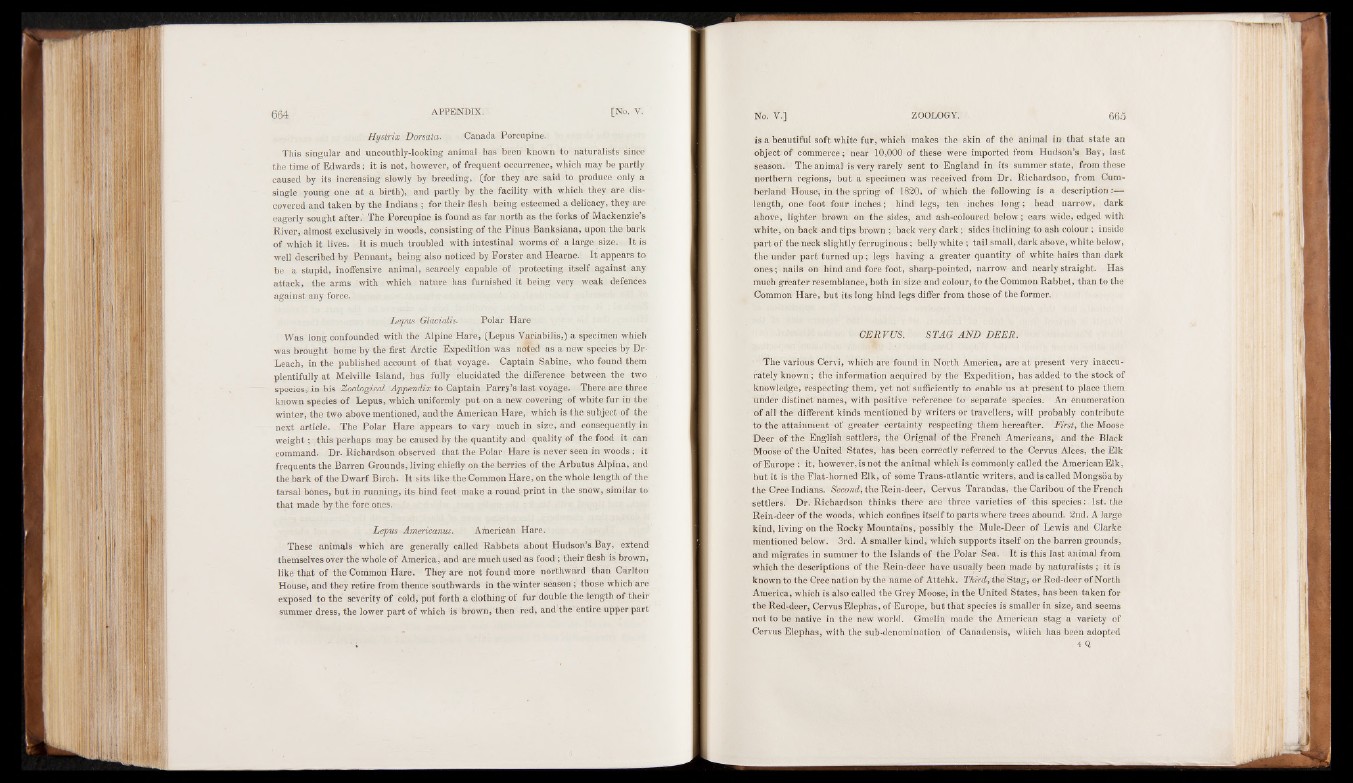
Hystrix Dorsata. Canada Porcupine.
This singular and uncouthly-looking animal has been known to naturalists since
the time of Edwards; it is not, however, of frequent occurrence, which may be partly
caused by its increasing slowly by breeding, (for they are said to produce only a
single young one at a birth), and partly by the facility with which they are discovered
and taken by the Indians ; for their flesh being esteemed a delicacy, they are
eagerly sought after.' The Porcupine is found as far north as the forks of Mackenzie’s
River, almost exclusively in woods, consisting of the Pinus Banksiana, upon the bark
of which it lives. It is much troubled with intestinal worms of a large size. It is
well described by Pennant, being also noticed by Forster and Hearne. It appears to
be a stupid, inoffensive animal, scarcely capable of protecting itself against any
attack, the arms with which nature has furnished it being very weak defences
against any force.
Lepus Glacialis.' Polar Hare
Was long confounded with the Alpine Hare, (Lepus Variabilis,) a specimen which
was brought home by the first Arctic Expedition was noted as a new species by Dr-
Leach, in the published account of that voyage. Captain Sabine, who found them
plentifully at Melville Island, has fully elucidated the difference between the two
species, in his Zoological Appendix to Captain Parry’s last voyage. There are three
known species of Lepus, which uniformly put on a new covering of white fur in the
winter, the two above mentioned, and the American Hare, which is the subject of the
next article. The Polar Hare appears to vary much in size, and consequently in
weight; this perhaps may be caused by the quantity and quality of the food it can
command. Dr. Richardson observed that the Polar Hare is never seen in woods ; it
frequents the Barren Grounds, living chiefly on the berries of the Arbutus Alpina, and
the bark of the Dwarf Birch. It sits like the Common Hare, on the whole length of the
tarsal bones, but in running, its hind feet make a round print in the snow, similar to
that made by the fore ones.
Lepus Americanus. American Hare.
These animals which are generally called Rabbets about Hudson’s Bay, extend
themselves over the whole of America, and are much used as food ; their flesh is brown,
like that of the Common Hare. They are not found more northward than Carlton
House, and they retire from thence southwards in the winter season; those which are
exposed to the severity of cold, put forth a clothing of fur double the length pf their
summer dress, the lower part of which is brown, then red, and the entire upper part
is a beautiful soft white fur, which makes the skin of the animal in that state an
object of commerce ; near 10,000 of these were imported from Hudson’s Bay, last
season. The animal is very rarely sent to England in its summer state, from these
northern regions, but a specimen was received from Dr. Richardson, from Cumberland
House, in the spring of 1820, of which the following is a description :—
length, one foot four inches; hind legs, ten inches long; head narrow, dark
above, lighter brown on the sides, and ash-coloured below ; ears wide, edged with
white, on back and tips brown ; back very dark ; sides inclining to ash colour ; inside
part of the neck slightly ferruginous ; belly white ; tail small, dark above, white below,
the under part turned up; legs having a greater quantity of white hairs than dark
ones ; nails on hind and fore foot, sharp-pointed, narrow and nearly straight. Has
much greater resemblance, both in size and colour, to the Common Rabbet, than to the
Common Hare, but its long hind legs differ from those of the former.
CERVUS. STAG AND DEER.
The various Cervi, which are found in North America, are at present very inaccurately
known ; the information acquired by the Expedition, has added to the stock of
knowledge, respecting them, yet not sufficiently to enable us at present to place them
under distinct names, with positive reference to separate species. An enumeration
of all the different kinds mentioned by writers or travellers, will probably contribute
to the attainment of greater certainty respecting them hereafter. First, the Moose
Deer of the English settlers, the Orignal of the French Americans, and the Black
Moose of the United States, has been correctly referred to the Cervus Alces, the Elk
of Europe ; it, however, is not the animal which is commonly called the American Elk,
but it is the Flat-horned Elk, of some Trans-atlantic writers, and is called Mongsoaby
the Cree Indians. Second, the Rein-deer, Cervus Tarandas, the Caribou of the French
settlers. Dr. Richardson thinks there are three varieties of this species : 1st. the
Rein-deer of the woods, which confines itself to parts where trees abound. 2nd. A large
kind, living on the Rocky Mountains, possibly the Mule-Deer of Lewis and Clarke
mentioned below. 3rd. A smaller kind, which supports itself on the barren grounds,
and migrates in summer to the Islands of the Polar Sea. It is this last animal from
which the descriptions of the Rein-deer have usually been made by naturalists ; it is
known to the Cree nation by the name of Attehk. Third, the Stag, or Red-deer of North
America, which is also called the Grey Moose, in the United States, has been taken for
the Red-deer, Cervus Elephas, of Europe, but that species is smaller in size, and seems
not to be native in the new world. Gmelin made the American stag a variety of
Cervus Elephas, with the sub-denomination of Canadensis, which has been adopted
4 Q